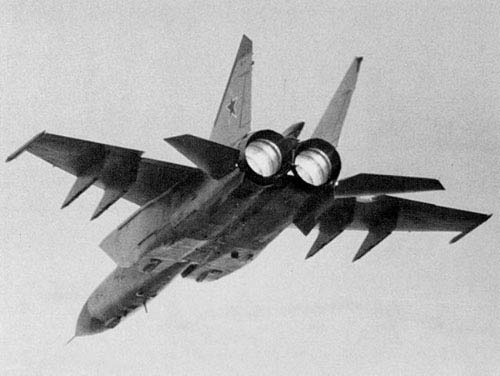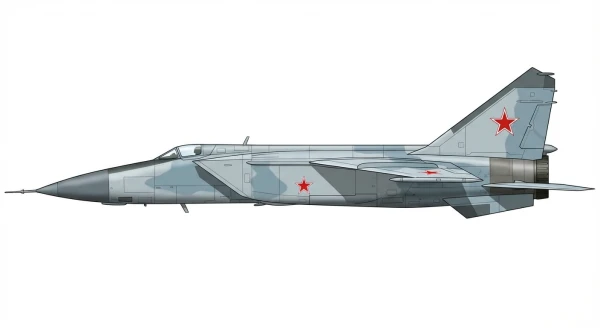MiG-25 Foxbat
Summary
| Category | Combat Aircraft |
| Origin country | 🇨🇳 Ex-USSR |
| Manufacturer | Mikoyan-Gurevitch |
| First flight | 6 March 1964 |
| Year introduced | 1970 |
| Number produced | 1186 units |
| Average unit price | $15 million |
Description
As soon as the Soviets became aware of the American XB-70 Valkyrie supersonic bomber program, they decided to develop an interceptor capable of countering this threat. Although the Valkyrie was later abandoned, the development of the new Soviet fighter continued. Initially designated as the Ye-155, the aircraft was named the MiG-25, with NATO analysts giving it the codename Foxbat. The aircraft retained many of its original characteristics, which earned it a flattering reputation in the West. The MiG-25 was built with a focus on speed, becoming the first military aircraft capable of reaching Mach 3 (the planned speed of the Valkyrie) and entering service. The developers at MiG sacrificed maneuverability in favor of speed to meet the requirements of the Soviet authorities. The MiG-25 was a pure interceptor, with limited maneuverability for dogfighting. Like all Soviet aircraft, the quality of its construction was deficient, as the military-industrial complex factories were not known for their quality control. However, the Foxbat was relatively lightweight, incorporating a large number of nickel and titanium components, capable of carrying four air-to-air missiles, and equipped with a powerful radar. It quickly caused alarm and even terror among Western officials, prompting them to initiate the construction of a "Foxbat Slayer," the F-15.
The Soviets quickly realized that the MiG-25 could be even more useful than originally planned. Multiple versions of the Foxbat were considered, but ultimately, its most important functions were interception and reconnaissance. With the ability to fly at Mach 3 thanks to a powerful engine and a fuselage resistant to high temperatures, the MiG-25 was a formidable interceptor, capable of climbing from 0 to 35 kilometers in less than 5 minutes. Between 1965 and 1978, numerous records for speed, altitude, and rate of climb were set by various modified versions of the MiG-25. It should be noted that at such altitudes, the combat potential of the aircraft was significantly reduced. However, it still posed a serious threat to the bombers of the Strategic Air Command.
Main variants: - MiG-25P (Foxbat-A): Introduced in 1969, entered service three years later; it was the basic version of the MiG-25. - MiG-25R (Foxbat-B): Reconnaissance variant, entering service in 1969; several sub-variants were derived from it, including the MiG-25RBSh (equipped with side-looking airborne radar) and the MiG-25RBF (Foxbat-D) for electronic reconnaissance. - MiG-25PU (Foxbat-C): Two-seat training variant for interception (with a RU variant also existing). - MiG-25PD (Foxbat-E): Significantly improved version developed from 1978 onwards to address the information obtained by the USAF about the MiG-25P in 1976 (defection of Victor Belenko to Japan); 370 MiG-25P aircraft were retrofitted to this standard.
Approximately 1,200 aircraft were produced by Soviet factories between 1969 and 1983, mostly serving in the Soviet Union itself. However, some states of the Warsaw Pact were also equipped with them, as well as a few export customers. Iraqi aircraft achieved the only two confirmed victories for the Foxbat, one in 1991 (a US Navy F-18, whose loss was unofficially acknowledged by the CIA, and whose wreckage was recently found in Iraq) and one in 2003 (an MQ-1 Predator drone). Currently, the MiG-25 is still in service with Russia (possibly around 70 examples), Syria (about thirty), Algeria, Libya, and Azerbaijan. A preserved example is held in Armenia, but it no longer appears to be airworthy. In all cases, the remaining officially active Foxbats are worn out, and their operational status is uncertain. In Russia (and possibly soon in Syria), the MiG-25 has largely been replaced by another MiG, which also incorporates a significant part of its structure: the legendary MiG-31 Foxhound.
The MiG-25 had a notable military career, often underestimated. It was frequently used as a reconnaissance aircraft and excelled in this role until the arrival of the American SR-71. Several Soviet aircraft conducted reconnaissance missions over Israeli territory between 1971 and 1973 without facing effective retaliation. India also used its Foxbats to fly over Pakistani territory without triggering an effective response. However, it appears that Iraqi Foxbats were overmatched by Iranian F-14 Tomcats during the war between the two countries from 1980 to 1988, with reports of eleven Iraqi aircraft shot down.
Technical specifications
| Version: MiG-25PD Foxbat-E | |
|---|---|
| Crew | 1 pilot |
| Operational range | 1,730 km (1,075 mi) |
| Maximum speed | 3000 km/h (1864 mph) |
| Wing area | 61.4 m² (660.9 sqft) |
| Wingspan | 14.0 m (46.0 ft) |
| Height | 6.1 m (20.0 ft) |
| Length | 23.8 m (78.1 ft) |
| Service ceiling | 20,700 m (67,913 ft) |
| Empty weight | 20,000 kg (44,092 lbs) |
| Max. takeoff weight | 36,200 kg (79,807 lbs) |
| Takeoff distance | 1,200 m (3,937 ft) |
| Powerplant | 2 x turbojets Tumansky R-15BD-300 delivering 7492 kgf each |
| Ejection seat | Mikoyan-Gourevitch KM-1 |
All operators
Armament




